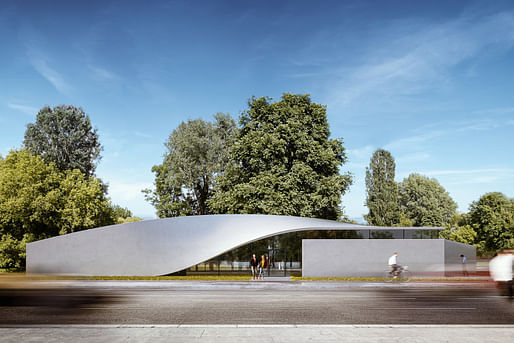

German architecture firm Henn, along with researchers at the Technical University of Dresden, has been working to create the first building in the world made of concrete reinforced by carbon fibers instead of steel.
Labeled as the world’s first building made of carbon concrete, the Cube is currently under construction on the Technical University of Dresden campus. Henn is working with the university’s Institute for Solid Construction, led by professor Manfred Curbach. The experimental 220-square-meter building is a showcase project from the “C³ - Carbon Concrete Composite” research initiative on innovative building materials funded by the German Federal Ministry of Education and Research. Through this project, carbon concrete is being researched and developed as a new combination of carbon and high-performance concrete.
According to the researchers, this type of concrete has the same structural strength as concrete reinforced with steel rebar but uses much less concrete. The concrete is reinforced with carbon fibers, which are bonded together using polymers. The fibers then come together in a kind of matric that the concrete is poured onto. According to Henn, the resulting material is four times lighter and four times stronger than normal reinforced concrete. It can also reduce carbon dioxide emissions from construction by up to 50%.
In addition, the carbon fiber material does not corrode, giving it a much longer lifespan than typical reinforced concrete. This also allows structures to be thinner as at least half of the concrete in a traditional building component is used to protect the steel reinforcement from decay.
The Cube will combine functions, offering spaces for laboratories and events and assemblies. Two shapes, a box and twist, come together to shape the sculptural building. The design reflects the textile nature of carbon fibers by merging the ceiling and walls into a single form. The roof is opened by a skylight, which emphasizes the structure’s organic form.
“With The Cube, we aim to make a contribution to the development and implementation of this future-oriented construction technology,” said Henn.
While carbon fiber-reinforced concrete seems to offer a sustainable substitute to its traditional counterpart, the main disadvantage is its cost. According to Allplan, one kilogram of reinforced concrete costs a little over a dollar to produce, while one kilogram of carbon concrete costs nearly $24. However, these figures do not reflect the actual difference in price as carbon concrete enables material savings through its durability, stability, and corrosion resistance. Therefore, the costs more closely balance out.
No Comments
Block this user
Are you sure you want to block this user and hide all related comments throughout the site?
Archinect
This is your first comment on Archinect. Your comment will be visible once approved.